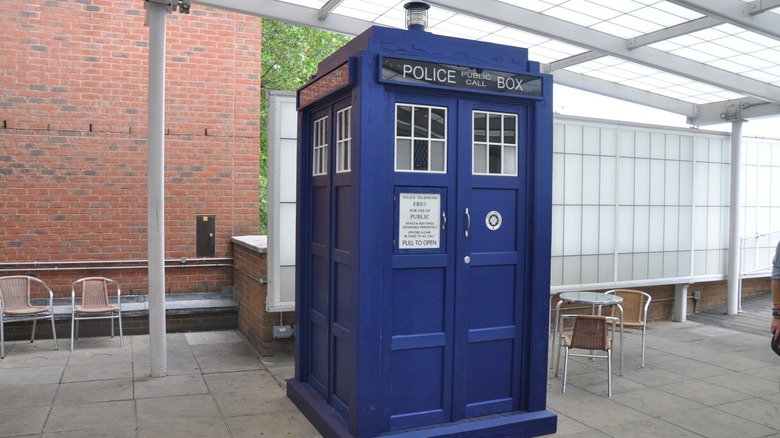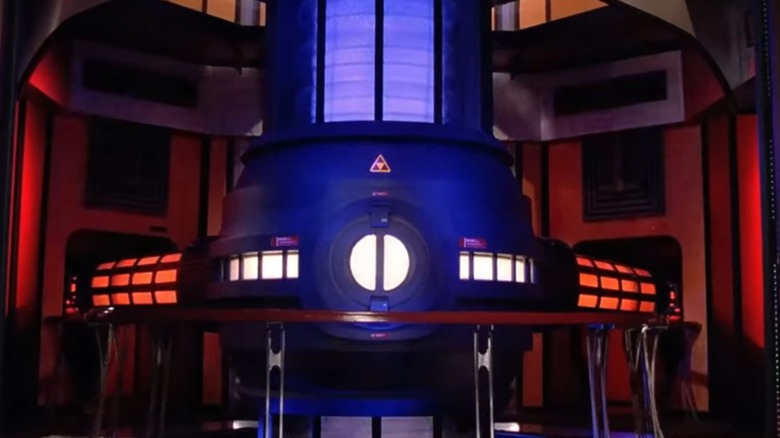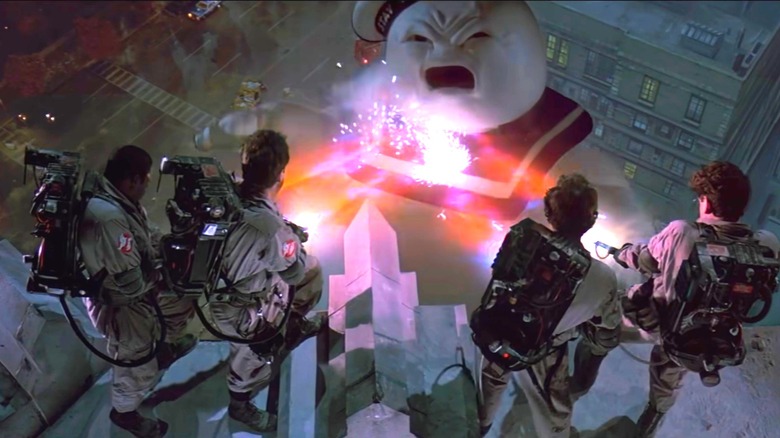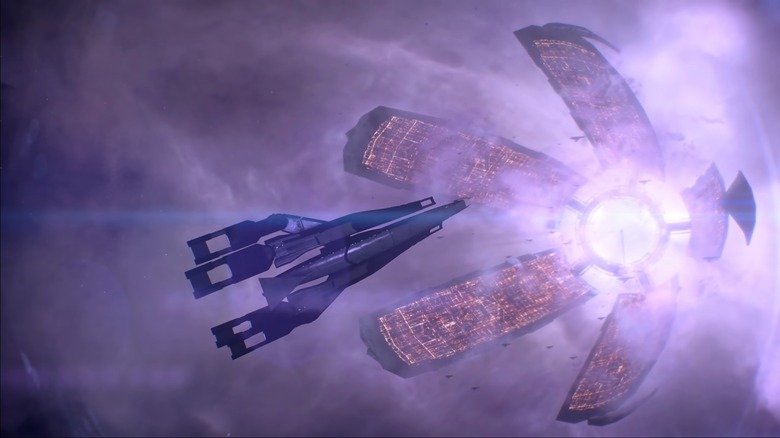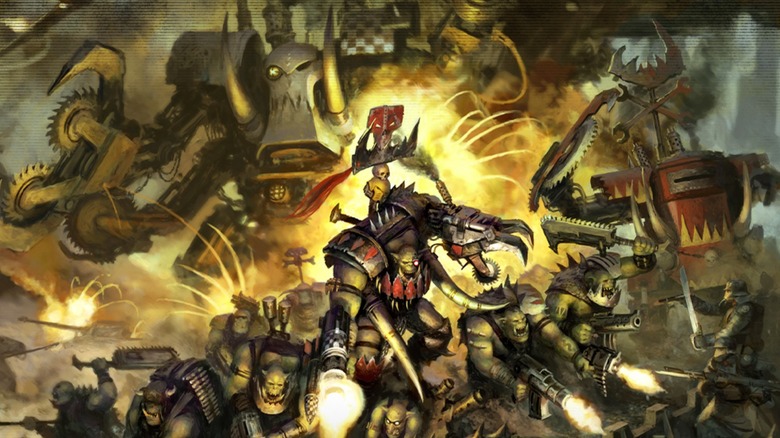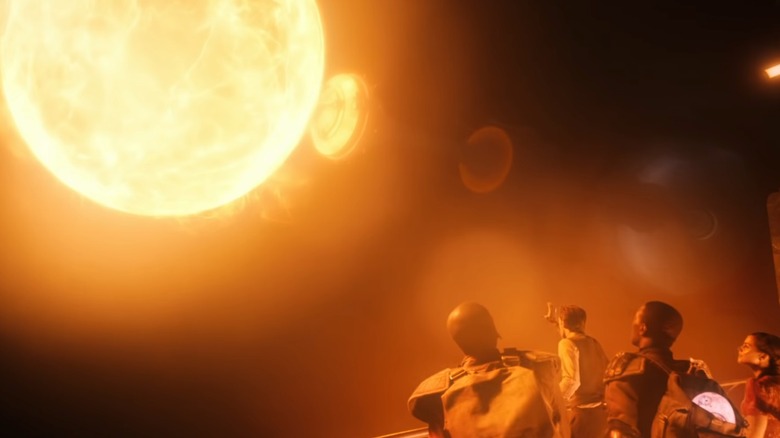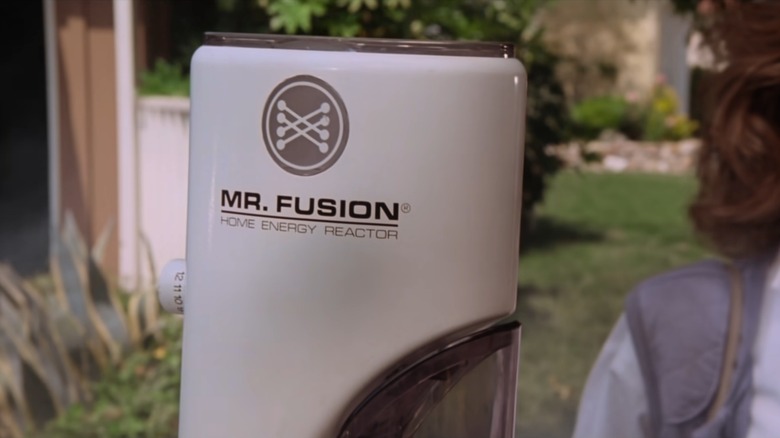The Ultimate Guide To Sci-Fi's 8 Coolest Power Sources
Every device in the real world requires a power source. Electricity and gas are some of the most common fuels, and many machines rely on components that convert one form of energy into another. Even science fiction devices require energy sources, especially if they don't want to fall into the "It's magic, I don't have to explain it" trope.
To provide an air of relative realism, many sci-fi properties at least partially explain how their technologies are powered. Since most of these devices defy the laws of physics as we (currently) know them, their power sources are equally far-fetched. Some of these fuels are based somewhat in reality and use energies we wish we could harness, while others create brand new elements out of whole cloth and invent energy conversion methods to go along with them. Depending on the imagination of the creative team, some sci-fi power sources stand out from others.
Here are some of the coolest power sources in all of sci-fi, either due to their iconic nature or sheer creativity.
[Featured image by Babbel1996 via Wikimedia Commons | Cropped and scaled | CC BY-SA 2.5]
Dilithium crystals and warp cores from Star Trek
"Star Trek" is the quintessential sci-fi franchise. The first series was ahead of its time, and it accurately predicted countless hi-tech devices. However, the ability to travel the stars still eludes us, probably because of the "science" behind the associated technology.
Whenever someone talks about the warp core of a Federation starship, "dilithium crystals" are usually part of the conversation. These minerals are a core part of the warp core (pun intended). The uninitiated might assume dilithium is the fuel behind the warp drives, but that is not true.
Contrary to popular belief, Federation starships travel faster than the speed of light thanks to a constant stream of matter/antimatter reactions. As any sci-fi aficionado (or theoretical physicist) will tell you, when matter and antimatter collide, they eliminate each other and produce so much power that, according to the U.S. National Science Foundation, calling the result an "explosion" would be an understatement. So why don't Federation ships explode all the time? Dilithium regulates the reaction and converts it into mechanical energy while within the warp core. Unfortunately, due to this ability, naturally formed dilithium lattices can literally tear planets apart. While we said dilithium is a crystalline reagent, earlier "Star Trek" stories also portrayed it as a complementary fuel source, but that purpose has essentially been retconned.
Dilithium is purely fictional, but if we ever invent a material capable of withstanding pure matter-antimatter annihilation, maybe it will help with faster-than-light travel too.
Proton packs from Ghostbusters
Usually, the undead are completely detached from science. True zombies are either resurrected or just somebody infected with a particularly nasty strain of rabies or cordyceps. But how does one scientifically explain something as phantasmal as a ghost? The same way they create an equally scientific way of busting ghosts.
Peter Venkman (played by Bill Murray) calls the iconic proton pack from "Ghostbusters" an "unlicensed nuclear accelerator" you can wear on your back. While Venkman often exaggerates, this claim is spot on. The science behind the proton pack is rooted in reality, albeit blown up to fictional proportions. Each proton pack is a nuclear-powered and unlicensed miniature cyclotron, i.e., a particle accelerator that continuously propels positively charged particles (protons) through a vacuum chamber. In the real world, cyclotrons are used for medical diagnoses and high-temperature fusion experiments. In "Ghostbusters," the proton pack cyclotron blasts protons at targets with a "neutrona wand."
While a proton pack's energy output has never been measured, the resulting streams are enough to significantly damage anything they hit. Technically ghosts in "Ghostbusters" aren't hurt by protons, just drained of energy since they are made up of negatively charged particles. Opposite charges attract, after all. However, due to the flipside of this universal principle — similar charges repel — if two proton streams hit each other, they could make every atom in your body rip apart at the speed of light.
Thankfully, ghosts don't actually exist, so we don't have to build real-life proton packs. And while one could construct their own portable cyclotron, it probably wouldn't pack the same firepower as the movie version.
Kyber crystals in Star Wars
More often than not, sci-fi weapons are some kind of destructive laser emitter. Laser rifles and pistols are the most common examples, but laser swords are a popular variant. Usually, laser swords and guns draw from the same batteries, but lightsabers buck this trend.
While most weapons in "Star Wars" run on power packs, lightsabers instead rely on the somewhat rare kyber crystals. These crystals don't provide the raw fuel necessary to power lightsabers, but they are a vital component nonetheless since they act as amplifiers. Energy focused through kyber crystals creates the iconic plasma blade that forms the "light" part of the "lightsaber."
Unlike regular crystals, kyber crystals contain organic components that react to people strong in the Force, which is what draws Jedi to them. However, that connection to the Force is also what lets Sith corrupt kyber crystals through a process known as "bleeding." It's just the act of pumping emotions such as fear, anger, and hatred into the crystal, but it's enough to create the signature crimson hue of Sith weaponry. Regardless of who uses a kyber crystal, though, the material remains impossibly strong, capable of withstanding blasts that would otherwise destroy a lightsaber and its wielder.
As much as we would love to swing around real lightsabers, without the impossibly fictional properties of a kyber crystal, the closest we'll ever get is a toy that shoots a thin stream of fire.
Element Zero in Mass Effect
In some sci-fi settings, different alien cultures have their own power sources. Federation ships in "Star Trek" rely on dilithium, while Romulans use artificial black holes. In "Mass Effect," the fictional Element Zero powers the technology of every species.
Element Zero, or "eezo" for short, is the lifeblood of the "Mass Effect" series, providing the in-universe explanation for almost all of the game's futuristic tech. Eezo is produced when planets are exposed to supernovas, and it generates a field of dark matter when exposed to electrical currents. This dark matter affects the mass of anything within its sphere of influence — positive currents increase mass, whereas negative currents decrease mass — hence the term mass effect.
While eezo isn't necessarily a fuel source, it reduces the energy required for interstellar flight by reducing the mass of spaceships and everything in them. The less something weighs, the less fuel it needs. However, eezo has many more in-universe uses. Because the element only requires a small amount of electricity to generate a mass effect field, everyday items such as guns, building materials, and even toothbrushes use it. Plus, while eezo dust is generally toxic, people who are exposed to the element in utero can develop special nodules in their bodies filled with it that generate dark energy fields, essentially giving them telekinetic abilities.
While Element Zero is purely fictional, dark matter itself is a hypothetically real material that might have helped form the universe as we know it. Just don't expect it to reinvent transportation or toothbrushes if we ever discover it.
WAAAGH! power in Warhammer 40K
The phrase "mind over matter" generally applies to situations where you make yourself feel better by thinking positively. In sci-fi, "mind over matter" goes beyond this mental placebo effect via psychic powers. Usually, these abilities are reserved for advanced civilizations, not warmongering hordes.
The Orks of "Warhammer 40K" are a big dumb murderball of a race. They can't count higher than three and are only concerned with fighting. While primitive compared to other factions, Orks frequently use guns and buggies, albeit ramshackle ones designed to be the coolest and killiest (their words, not ours). Ork tech is so unstable it tends to blow up in their users' faces. And despite being responsible for its construction, Ork mechanics (called meks) don't actually know how their technology works.
They may look brutish, but all Orks are psychic — most are just too dumb to realize it. When they put their empty heads together, their collective gestalt psychic power changes reality, forcing mek creations to work simply because Orks believe they work. Without this energy, sometimes referred to as "WAAAGH! power" after the Ork battlecry, Ork guns and vehicles are inanimate scrap. This low-level psychic field can subtly alter how Ork tech functions, too. Vehicles painted red drive faster, and yellow missiles and bombs provide larger explosions, all because of their paint jobs.
While the power to make something happen simply because you believe in it sounds childish, Orks demonstrate that in the right (or wrong) hands, it can devastate entire galaxies.
The Eye of Harmony from Doctor Who
"Doctor Who" has aired off and on since 1963. While the show is seemingly about the adventures of a human-like alien and their time machine, calling the TARDIS just a simple "time machine" would be a disservice to its capabilities and power requirements.
In the show's canon, the TARDIS can do more than time travel; it also houses a potentially infinite number of rooms and can disguise itself to blend in with its surroundings. Well, it could if its "chameleon circuit" wasn't broken. The amount of energy needed to power all these functions would have to be, well, infinite, so how did the Time Lords manufacture enough power generators to fuel a fleet of these vehicles?
The Eye of Harmony is the central power source for every TARDIS in the universe of "Doctor Who." Instead of using artificial stars or black holes, the Time Lords did one better by depositing a star on the verge of exploding into the center of the space-time continuum. They then suspended the star in a state of permanent decay, making it give off infinite energy as it collapsed into a black hole that would never be. The result: more than enough raw power to fuel every TARDIS and all of Time Lord society.
However, that's just the current canon. "Doctor Who" has been running for so long that the Eye of Harmony has been reimagined a few times, as both the source of Time Lord regeneration and of time itself. In another decade or two, and someone will probably rewrite how it works yet again.
Mr. Fusion from Back to the Future
The "Back to the Future" DeLorean uses a Flux Capacitor to become a time machine, but it needs to refuel with rare energy sources after each time jump. At least until its inventor harnessed the power of futuristic technology.
At the end of the original "Back to the Future," Doc Brown uses his DeLorean to bring Marty McFly back to the future. Before he does, though, Doc refuels his Flux Capacitor by throwing random trash into something labeled "Mr. Fusion Home Energy Reactor." This device from the distant future of 2015 is a fusion reactor that can break anything put into it down into energy, and it isn't some luxury item either. Background details in "Back to the Future Part II" imply that Mr. Fusion is a cheaper, consumer-friendly member of a larger line of reactors by "Fusion Industries."
The Flux Capacitor's power requirements are a major plot element of the original "Back to the Future" film. Each jump requires 1.21 gigawatts, which ain't easy to find — it took conning angry Libyan terrorists out of plutonium and channeling a direct bolt of lightning. In 2015, Mr. Fusion can provide that much by burning banana peels and beer, with enough energy left over to power the DeLorean's hover technology.
It's difficult to tell which aspect of the Mr. Fusion reactor is more impressive: its potential power output or its potential for solving Earth's trash problem. But can it charge a Mattel hoverboard?
Coral from Armored Core 6
We may all want to drive sci-fi mechs, but their very nature defies the laws of physics. Not only are mechs tougher and faster than they have any right to be, but their power requirements should be through the roof. While many sci-fi settings avoid that immersion pitfall by simply ignoring it, this game ties mech power sources into its story with all the grace we've come to expect from FromSoftware.
"Armored Core" players have always had to balance power requirements when customizing their mechs, but the in-universe mechanics of mech generators were never important until the introduction of "Coral." In "Armored Core 6: Fires of Rubicon," this miracle material is a highly efficient fuel. Not only does Coral provide a ton of energy when burned, but it is also self-replicating. With Coral, many devices, Armored Core units included, can go years without refueling. That property sounds like it should defy all known natural laws, at least until you learn about Coral's true nature.
In truth, Coral isn't just a fuel: It's a colonial microorganism that can reproduce exponentially and semi-indefinitely. Granted, using microbes for gas isn't new — real-world scientists are experimenting with using glowing dirt in biofuels — but Coral goes above and beyond because it also exhibits some intellect. This property is demonstrated by Coral's ability to serve as a data conduit and, more importantly (warning: spoilers), control machines and spawn humanoid personalities.
Here's hoping future microbe biofuels don't end up being anywhere near as intelligent as Coral.
